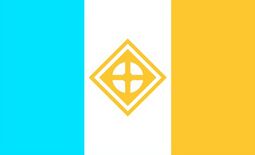Flag of Zoygaria: Difference between revisions
No edit summary |
|||
| Line 48: | Line 48: | ||
File: Kingdom_of_Zoygaria_(alt).jpg| Alternate flag of the Kingdom of Zoygaria (1740-1804). | File: Kingdom_of_Zoygaria_(alt).jpg| Alternate flag of the Kingdom of Zoygaria (1740-1804). | ||
File: Flag_of_the_Kingdom_of_Zoygaria.jpg| The 2nd flag of the Kingdom of Zoygaria (1775-1912), flown concurrently with its predecessor until 1804, when it became the sole official flag. | File: Flag_of_the_Kingdom_of_Zoygaria.jpg| The 2nd flag of the Kingdom of Zoygaria (1775-1912), flown concurrently with its predecessor until 1804, when it became the sole official flag. | ||
File: | File: Tricolora Magna (con aquila).png| 1st flag of the Imperial Commonwealth of Zoygaria (1912-1964). | ||
</gallery> | </gallery> | ||
[[Category:Zoygaria]] | [[Category:Zoygaria]] | ||
Revision as of 19:37, 17 October 2023
 | |
| Name | Li Invirnostai |
|---|---|
| Use | National flag and state ensign |
| Proportion | 3:5 |
| Adopted | 7 February 1964 |
| Design | Pale azule, argent, and or defaced by Flora Aurata |
| Designed by | Augustus III |
The national flag of Zoygaria (Zoygarian: La Bandiera de Zoyivsca) consists of three equal stripes of blue, white, and yellow defaced by the Zoygarian Flora Aurata. It was designed in 1964 by Augustus III of Zoygaria as a replacement for the previous flag of the Imperial Commonwealth, becoming the new national flag on the Zoygarian national holiday of Hirata. As an homage to Zoygaria's famous biting winters and the icy blue of the flag, King Augustus dubbed the flag Li Invirnostai in Zoygarian, translating to The Winterhold or The Wintergrip in English.
Design
Colors
The Zoygarian flag is in 3:5 aspect ratio, a ratio mirrored by the flags of its constituencies. The shade of blue on the Zoygarian flag is officially classified by the Zoygarian government as cyan, described by poet Nataša Čerdenca as "a brilliant shade of electric winter blue, clear as the endless sky and blinding as the approaching snowy maelstrom, a herald of Zoygaria's triumphant past and shining future." The current version of the flag was created in 1964 by King Augustus III in an effort to distance Zoygaria from its trouble-ridden past, particularly following the World War and The Collapse under the nation's late former king, and was intended to signal the beginning of an era of prosperity for the country. According to King Augustus, the flag was to serve as "a fresh coat of paint"— a new flag paired with a new ruler.
| Color model | Cyan | White | Gold |
|---|---|---|---|
| HTML | #00E3FE | #FFFFFF | #FDC72F |
Symbolism
Blue, white, and yellow has long been the historical standard of Zoygaria, with the first instances of a true royal banner coming about under the Zoygarian Empire, before which only royal standards were used to represent armies and kingdoms. A tri stripe of blue, white, and gold was first used by the Kingdom of Zoygaria in 1775. This tricolor became the basis for the later flag of the Imperial Commonwealth, from which the current flag takes its inspiration. According to the National Zoygarian Institute of Vexillology (INZV), "Cyan represents peace, grace, and the glory of days gone by. White, the balancing shade, represents honor, humility, and balance. Gold represents prosperity, hope, and the rising dawn, also symbolic of the dawn of a new Zoygaria."
The golden flower in the center is a deeply cultural symbol, representing the Zoygarian identity, culture, and people. First seen on the war banner of King Viltivi I, it became a symbol of the country and its people, featured prominently in signs, documents, and even dress. The design of the flower itself is also very representative of Zoygaria, as many Zoygarian symbols and icons feature triangular and diamond-like shapes, a pattern which the golden flower follows. The Flora Aurata is featured in some form or another on several of the flags of Zoygaria's constituencies, something that Prime Minister Saito Solsci remarked as "A shining example of Zoygaria's motto: One Nation, One People."






